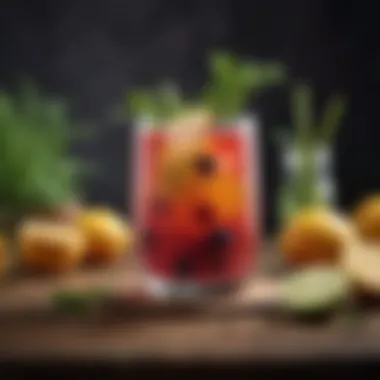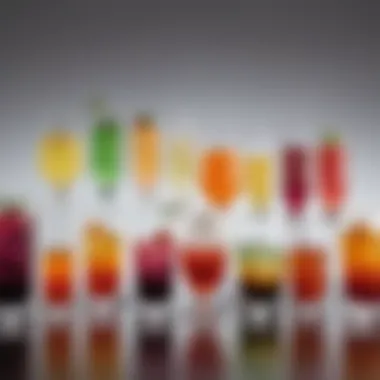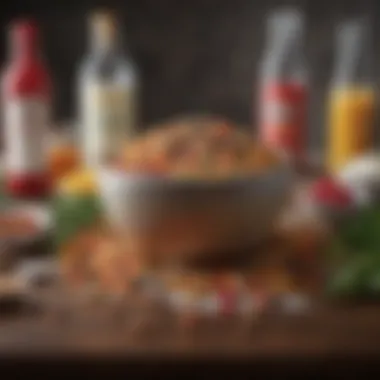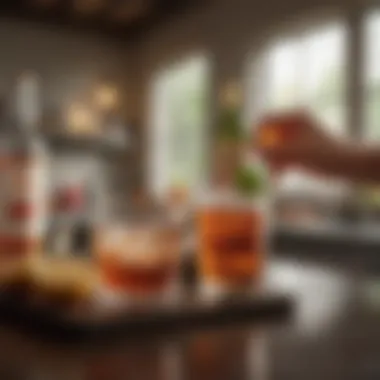Exploring Nonalcoholic Beverages for Every Occasion


Intro
The recent inclination towards nonalcoholic beverages reflects a growing shift in consumer behavior, emphasizing health and mindfulness. As conventional norms around drinking evolve, many individuals seek out alternatives that provide satisfaction without the effects of alcohol. Nonalcoholic drinks are not only for designated drivers or those abstaining for health reasons; they cater to a wide audience looking for enjoyable, refreshing choices. The spectrum of these beverages is vast and varied, encompassing everything from sparkling waters to artisanal mocktails.
This article will explore different facets of nonalcoholic beverages. It will delve into their categories, unique flavors, and health implications. There is a growing desire for inventive recipes and insights into the trends dominating the nonalcoholic sector. Mindful drinking has fostered an innovative landscape, offering a plethora of drinking experiences that enhance social gatherings, personal enjoyment, and overall well-being.
As we navigate through this diverse world, readers will find not only valuable information about popular drinks but also creative recipes tailored for various occasions. The exploration of nonalcoholic beverages promises to present delicious options while considering health benefits, ensuring that everyone can find their ideal drink.
Prolusion to Nonalcoholic Drinks
Nonalcoholic drinks have gained significant importance in recent years. With a broad spectrum of choices, these beverages cater to a diverse audience looking for alternatives to traditional alcoholic options. The discussion surrounding nonalcoholic drinks is more than just about their ingredients; it encompasses cultural shifts, health benefits, and lifestyle choices. Understanding nonalcoholic drinks means recognizing their relevance in various social settings and their role in promoting mindful consumption.
Definition and Relevance
Nonalcoholic drinks refer to any beverage that contains little to no alcohol. This definition encompasses a wide range of options, including soft drinks, juices, teas, and other creatively crafted beverages designed to provide enjoyment without alcohol. The relevance of nonalcoholic drinks extends beyond mere definitions. They serve as inclusive options for social events, catering to individuals who either choose not to consume alcohol for personal, health, or cultural reasons. Nonalcoholic beverages promote social interaction, ensuring that everyone can participate in gatherings without feeling excluded.
Furthermore, these beverages often boast unique flavors and ingredients, appealing to a growing market interested in flavor exploration. They engage a variety of taste preferences, ensuring satisfaction for drinkers of all ages.
The Rise of Mindful Drinking
The rise of mindful drinking marks a pivotal transition in beverage preferences. This movement is not solely about abstaining from alcohol but rather about making intentional choices regarding one’s drinking habits. Consumers today are increasingly aware of their health and how certain substances affect their bodies. As a result, many are turning to nonalcoholic drinks as a way to enjoy social occasions while prioritizing their well-being.
Mindful drinking encourages individuals to be conscious of their alcohol intake, allowing for a thoughtful analysis of reasons behind drinking. This shift leads to a more enjoyable experience, focusing on the flavors and the moment rather than the intoxicating effects of alcohol.
"Mindful drinking is about being present and reflective on choices, rather than following societal norms that may not fit everyone."
As this trend grows, the beverage industry is adapting, introducing more innovative and flavorful nonalcoholic options. This evolution reflects a broader cultural change towards health awareness and self-care. Rather than viewing nonalcoholic drinks as mere substitutes, consumers see them as an opportunity to explore complex flavors and concoct unique experiences.
Types of Nonalcoholic Drinks
The category of nonalcoholic drinks offers a vast selection, catering to diverse preferences and occasions. Understanding these types helps consumers make informed choices, whether they seek refreshment, health benefits, or culinary creativity. Nonalcoholic beverages serve as excellent alternatives to traditional alcoholic drinks, appealing to individuals who choose to abstain from alcohol for health, lifestyle, or personal reasons. Moreover, the growing interest in mindful drinking highlights the demand for flavorful, satisfying nonalcoholic options.
Let’s explore the main types of nonalcoholic drinks available today and their unique characteristics.
Soft Drinks
Soft drinks are carbonated beverages that come in a variety of flavors, from cola to fruit varieties. They often contain high levels of sugar, although sugar-free options are widely available. Soft drinks are immensely popular, particularly among younger demographics. The fizz and sweetness can provide a quick energy boost or a refreshing burst, making them ideal for casual settings or gatherings.
While soft drinks can be enjoyable, it’s noteworthy to consider their health implications. Regular consumption can lead to increased caloric intake and health issues like obesity or dental problems. Thus, moderation is key. Many brands now offer low-calorie or zero-calorie alternatives to appeal to health-conscious consumers.
Juices and Smoothies
Juices and smoothies stand as vibrant nonalcoholic options filled with nutritional benefits. Juices are typically made by extracting the liquid from fruits or vegetables. They can be refreshing and hydrating. Meanwhile, smoothies blend whole fruits and vegetables, which retain fiber and other essential nutrients.


Both can operate as hearty options for breakfast or snacks. However, when selecting juices, it is crucial to choose those that are 100% juice without added sugars or preservatives. This ensures the health benefits are maximized. On the other hand, smoothies can be tailored to personal preference, allowing for the addition of proteins, nuts, or seeds for extra nutrition.
Herbal and Infused Teas
Herbal and infused teas serve as another exceptional category of nonalcoholic drinks. Made from a variety of herbs, spices, and fruits, these beverages are often caffeine-free and provide soothing qualities. Common types include chamomile, peppermint, and hibiscus. They offer numerous health benefits, such as aiding digestion or promoting relaxation.
Infused teas can also enhance the drinking experience. Users often experiment with various ingredients to craft unique flavors. They can be served hot or cold, making them versatile for any season. Some brands even promote specific health benefits, increasing their appeal to consumers seeking natural remedies.
Nonalcoholic Beer and Wine
Nonalcoholic beer and wine have gained considerable traction in recent years. These drinks mimic the taste and experience of traditional alcoholic options without the intoxicating effects. Made through various processes, including removing alcohol from fermented beverages, they allow individuals to enjoy social settings without alcohol.
The flavor profiles of nonalcoholic beer and wine have significantly improved, capturing the nuances often found in their alcoholic counterparts. This advancement mitigates the stigma surrounding nonalcoholic options, making them a satisfactory choice for many. They are perfect for celebrations where some might prefer to stay sober yet still partake in the experience.
Mocktails
Mocktails represent a creative fusion of flavors, delivering complex and refreshing drinks without alcohol. Combining various ingredients such as juices, herbs, and garnishes, mocktails cater to those seeking the joy of a well-crafted beverage. They often replicate traditional cocktails, offering a similar aesthetic and taste experience.
The presentation is an essential aspect of mocktails, often enhancing the enjoyment and sophistication they provide. Those who opt for mocktails can savor unique flavor combinations while remaining alcohol-free. Many bar and restaurant menus now include specialty mocktail offerings, showcasing the demand for these beverages.
In summary, the types of nonalcoholic drinks highlight the diverse range available. From soft drinks to herbal teas, each type presents unique benefits and flavors that serve different preferences and occasions.
Crafting the Perfect Nonalcoholic Drink
Crafting the perfect nonalcoholic drink is an essential aspect of creating enjoyable beverages for various occasions. Nonalcoholic options should not only refresh but also offer a sense of satisfaction and pleasure. The act of crafting allows for creativity and personal expression, making it a rewarding experience. This section will examine how to choose the right ingredients, balance flavors and textures, and present the drinks beautifully—each of which plays a crucial role in successfully creating a delightful nonalcoholic drink.
Choosing the Right Ingredients
Selecting the right ingredients is fundamental in crafting a nonalcoholic drink. The quality and appropriateness of each element can greatly influence the final product. Opting for fresh, seasonal fruits and herbs can enhance flavors and offer nutritional benefits. For instance, ripe strawberries or mint leaves can elevate simple drinks into something extraordinary.
When considering ingredients, think about the drink's purpose and audience. For casual gatherings, vibrant juices like pineapple or orange can be crowd-pleasers. However, for more sophisticated events, opting for unique herbal infusions may create a conversation starter.
Another vital aspect is the balance of sweetness and acidity. Using natural sweeteners like honey or agave syrup can introduce complexity while keeping the drink health-conscious. Additionally, incorporating ingredients such as citrus or vinegar can add a necessary tang, enhancing the overall experience.
Balancing Flavors and Textures
Balancing flavors and textures is key to creating an enjoyable drinking experience. It is essential to think about the harmony between sweet, sour, bitter, and umami elements. Each drink should aim for a well-rounded profile that includes various tasting notes.
Textures also play a significant role. Including sparkling water or tonic can add a lively element through carbonation, while creamy ingredients like coconut milk can provide a luxurious mouthfeel. When designing a nonalcoholic drink, it’s important to consider how these flavors and textures interact.
"A perfect nonalcoholic drink combines diverse flavors and engaging textures to create a memorable experience."
Experimenting with blends is encouraged. For example, mixing herbal tea with a hint of fruit juice can make for an engaging beverage. Try different combinations until the right balance resonates. This experimentation can also help identify unique flavor profiles that might become favorites.
Presentation Techniques


The presentation of nonalcoholic drinks is often underestimated, yet it can significantly affect one’s overall impression. Aesthetic appeal can heighten the enjoyment of the drink, making it memorable.
Consider using visually striking glassware. For example, using tall fluted glasses can lend an air of sophistication. Garnishes also serve as an impactful visual element. Fresh herbs, citrus slices, or edible flowers can add color and intrigue.
A well-thought-out color palette is beneficial as well. Drinks with a range of colors can be very appetizing. Layered drinks, where each component is visible, can also create a sense of anticipation and excitement.
Finally, engaging the senses through evocative smells is another consideration. Consider finishing drinks with a citrus zest or fragrant herb sprig to captivate the aroma. Overall, making the drink visually appealing can enhance the whole experience, inviting your guests to indulge.
Popular Nonalcoholic Drinks by Occasion
The consumption of nonalcoholic beverages has evolved beyond just simple substitutes for their alcoholic counterparts. Their versatility makes them suitable for different occasions. Understanding the types of nonalcoholic drinks that enhance specific moments can deeply enrich the social experience and promote inclusivity. This section explores various occasions and the nonalcoholic drinks that pair seamlessly with them. Both flavor and context matter when selecting the right drink for your gathering.
Celebrations and Parties
In festive settings, like weddings, birthdays, or any gathering aimed at celebration, nonalcoholic beverages play a crucial role. They provide options for guests who may wish to abstain from alcohol for personal or health reasons, while still allowing for a festive atmosphere. Common celebratory drinks include sparkling waters infused with fruits or herbs. They create a visual appeal, often served in elegant glassware to match the occasion's spirit.
Mocktails, which are alcohol-free cocktails, have also gained popularity. Recipes like a Virgin Mojito or a Nojito can incorporate vivid colors and intricate garnishes, making them a centerpiece of the celebratory table.
"Nonalcoholic drinks not only serve those who avoid alcohol but enhance the environment, creating a more inclusive atmosphere."
When planning a party, consider creating a signature drink that aligns with the theme. This can spark creativity and engagement, allowing you to offer a comprehensive drinking experience.
Everyday Refreshments
For daily hydration and refreshment, a variety of nonalcoholic drinks can be tailored to suit various tastes. Lemonades, iced teas, and flavored carbonated waters offer invigorating choices that can be enjoyed any time. The beauty of these beverages lies in their simplicity, yet there's room for sophistication. Experimenting with flavors can elevate basic drinks to daily delights.
Creating beverages from fresh ingredients is appealing. Smoothies made from a mix of fruits or vegetable juices can also serve as a nutritious choice. They are not only refreshing but also provide vitamins and minerals. For those looking to cut down sugar, unsweetened herbal teas are great options that can be served hot or cold.
Health-Conscious Choices
With rising health awareness, many individuals seek nonalcoholic beverages that provide nutritional benefits. Drinks that emphasize hydration and low-calorie options are especially vital. Herbal teas have notable benefits; certain blends can aid digestion or relaxation. Juicing fresh vegetables is another powerful way to introduce essential nutrients into one's diet without the added sugars of many commercial drinks.
Nonalcoholic drinks can be low in calories while still remaining flavorful. For instance, infused water can be a great substitute, combining water with slices of citrus or berries. This not only enhances flavor but also encourages individuals to increase their daily fluid intake.
In summary, the exploration of nonalcoholic drinks across various occasions reveals a landscape rich in options. Whether it's a vibrant celebration, a refreshing day-to-day drink, or a health-conscious choice, understanding these dynamics allows for thoughtful selection and preparation. This ensures every individual has the opportunity to enjoy their drink of choice.
Health Benefits of Nonalcoholic Drinks
Nonalcoholic drinks have become increasingly popular due to their significant health benefits. With a rising focus on wellness and mindful drinking, these beverages offer appealing alternatives without the adverse effects of alcohol. Understanding the health benefits associated with these drinks is essential. It not only caters to those seeking healthier lifestyle options but also enhances the overall beverage experience.
Hydration and Nutritional Value
One of the primary benefits of nonalcoholic drinks is their ability to support hydration. Staying adequately hydrated is crucial for various bodily functions, including digestion, temperature regulation, and cognitive performance.


Nonalcoholic beverages range from flavored waters to fruit juices, providing essential vitamins and minerals. Here are some advantages:
- Enhances Hydration: Many nonalcoholic drinks are water-based, contributing to overall fluid intake.
- Provides Nutrients: Options such as coconut water and vegetable juices deliver vitamins like C and K.
- Supports Health: Herbal teas and infused waters often contain antioxidants which help in reducing oxidative stress.
Hydration from these drinks can combat fatigue and improve mental clarity, making them a favored choice for those looking to integrate nutrition into their beverage options.
Lower Caloric Impact
Another major health benefit of nonalcoholic drinks is their typically lower caloric impact compared to alcoholic beverages. Many nonalcoholic choices have little to no added sugars, making them suitable for those watching their caloric intake.
Some key points to consider include:
- Caloric Control: Nonalcoholic beer and spirits are often fewer calories than their alcoholic counterparts.
- Weight Management: Regularly consuming nonalcoholic options can help in managing weight by avoiding the extra calories from alcoholic drinks.
- Sugar Alternatives: Nonalcoholic drinks may utilize healthier sugar alternatives or natural flavors, reducing empty calorie consumption.
By choosing nonalcoholic beverages, individuals can enjoy their drinks with much lesser guilt concerning caloric consumption, fitting into various dietary plans and promoting overall health.
"Nonalcoholic beverages can improve hydration, provide nutrition, and support a balanced lifestyle without the burden of added calories and alcohol effects."
Innovations in Nonalcoholic Beverages
Innovations in the realm of nonalcoholic beverages play a pivotal role in shaping consumer preferences and creating exciting options for various occasions. As the trend of mindful drinking grows, the beverage industry is responding to a larger demand for creative drinks that do not compromise on flavor or enjoyment. Nonalcoholic beverages are no longer perceived as mere alternatives to alcohol; they are evolving into unique experiences in their own right.
Trends in Flavor Profiles
The diversification of flavors is one of the most significant trends in nonalcoholic beverages. Consumers now seek out complex and intriguing taste experiences that go beyond the traditional sweet and carbonated drinks.
- Herbal and Botanical Infusions: Infusions of herbs and botanicals are gaining popularity. Drinks such as elderflower and hibiscus sodas offer delicate yet distinctive flavors, appealing to those looking for something fresh.
- Spiced Beverages: Spices like ginger, turmeric, and cardamom are being incorporated into drinks for their health benefits and rich taste. For instance, turmeric-based nonalcoholic cocktails can provide a warm and vibrant flavor profile that intrigues the palate.
- Savory Elements: The introduction of savory flavors, such as tomato and pickle juice, showcases a shift away from sweet-centric options. This opens a new frontier for cocktails and mocktails that cater to various taste preferences without the alcohol content.
These flavor innovations not only satisfy various tastes but also cater to the increasingly health-conscious consumer. Each sip offers a blend of enjoyment and potential health benefits, promoting a more engaging drinking experience.
Sustainable Practices
Sustainability is a vital aspect of innovations in nonalcoholic beverages. As awareness of environmental issues increases, companies are in search of eco-friendly practices. A few key areas of focus include:
- Sourcing Ingredients Ethically: Many brands are moving towards sourcing ingredients locally and sustainably. This minimizes the carbon footprint associated with transporting ingredients and supports local agriculture.
- Eco-Friendly Packaging: The shift to sustainable packaging is prominent, with options such as biodegradable materials and reusable containers being developed. This reduces environmental waste and aligns with consumer values.
- Waste Reduction Efforts: Innovative practices to reduce waste during production are being implemented. Companies are exploring ways to utilize byproducts, such as using pulp from juice production to create new beverage lines, effectively maintaining an eco-conscious approach.
Closure
The examination of nonalcoholic beverages is essential in today’s evolving drinking culture. As more individuals turn towards healthier lifestyles, the demand for diverse and satisfying nonalcoholic options is expanding. This article highlights not just the varieties of available drinks but also their impact on social gatherings, health benefits, and personal choices.
The Future of Nonalcoholic Beverages
Looking ahead, the nonalcoholic beverage industry holds enormous potential. Several factors contribute to this promising outlook:
- Innovation in flavors: As consumers crave unique experiences, brands are developing more complex and varied flavor profiles. Nonalcoholic spirits and wines are being crafted with the same level of care as their alcoholic counterparts. This shift elevates the options available and draws in those who seek quality over quantity.
- Increased accessibility: Retailers are expanding their shelves to include nonalcoholic products, making it easier for consumers to discover new drinks beyond traditional sodas and juices. The rise of specialized online marketplaces also allows individuals to explore a broader range of brands and products.
- Focus on health and wellness: With a growing awareness of health issues linked to alcohol consumption, many people are opting for nonalcoholic drinks as part of their wellness journey. Nutrient-rich options that support hydration and provide essential vitamins are becoming more prominent.
"The shift towards mindful drinking is redefining not just personal habits but also the drinks we choose for social occasions."
- Sustainability initiatives: An increasing number of brands are adopting eco-friendly practices, such as using sustainable ingredients and packaging. This conscientious shift appeals to environmentally aware consumers, further driving interest in nonalcoholic choices.
Ultimately, the future of nonalcoholic beverages is bright. As trends continue to evolve and consumer preferences shift, the market for rich, enjoyable drinks without alcohol will only grow. This evolution is not merely about the absence of alcohol but rather the presence of excitement, flavor, and health-conscious choices, allowing everyone to participate in social drinking experiences.







